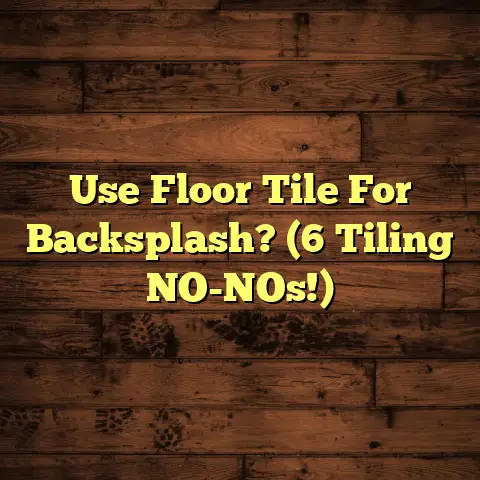Roomba Floor Cleaning Solution: What To Use? (2 Options)
Remember the days when vacuuming meant lugging around a
heavy machine, dodging furniture, and wrestling with cords?
Yeah, me too.
Then came the Roomba, a little disc of
cleaning magic that promised to revolutionize how we
maintain our living spaces.
And honestly, it delivered!
The Roomba, and robotic vacuum cleaners in general,
represent a huge leap forward in home maintenance.
They’re
convenient, efficient, and packed with impressive
technology.
It’s no wonder Roomba has become synonymous
with robotic floor cleaning.
It tackles the never-ending
challenge of keeping our homes clean amidst our busy lives.
But here’s the thing: a Roomba is only as good as the
cleaning solution you use.
So, let’s get down to brass
tacks and figure out the best options for your floors.
Section 1: Understanding the Roomba Technology
1. The Evolution of Robotic Vacuum Cleaners
Before Roomba became a household name, the idea of a
robotic vacuum cleaner was mostly science fiction.
The
first attempts were clunky, unreliable, and often more
trouble than they were worth.
But then, in 2002, iRobot launched the Roomba, and
everything changed.
It wasn’t perfect, but it was a
significant step forward.
The early models used basic
sensors to navigate and avoid obstacles.
Over the years, the Roomba has evolved dramatically.
It’s gone from bouncing randomly around the room to using
sophisticated mapping technology, smart connectivity, and
even artificial intelligence.
These advancements have
made Roomba a true household hero.
2. How Roomba Works
So, how does this little cleaning machine actually work?
Well, it’s a combination of clever engineering and
advanced technology.
At its core, a Roomba uses a system of brushes and suction
to pick up dirt, dust, and debris from your floors.
The side brush sweeps along edges and corners, while the
main brush or brushes agitate the dirt, allowing the
vacuum to suck it up.
The navigation system is where things get interesting.
Early models used simple bump sensors to change direction
when they encountered an obstacle.
Newer models, however,
use cameras, lasers, and infrared sensors to create a map
of your home.
This allows them to clean more efficiently
and avoid obstacles with greater precision.
Different Roomba models come with unique features.
Some
have self-emptying bins, others can be controlled with
your smartphone, and some can even mop as well as vacuum.
It’s a cleaning army in one small package!
3. Benefits of Using a Roomba
Now, let’s talk about why you should consider adding a Roomba to your cleaning arsenal.
Time-Saving: This is the big one.
Instead of spending
hours vacuuming each week, you can let your Roomba do the
work for you.
Set it to run on a schedule, and you’ll
come home to clean floors every day.Efficiency: Roombas are surprisingly efficient at
cleaning.
They can get into tight spaces, under furniture,
and along edges that are difficult to reach with a
traditional vacuum.Ease of Use: With smartphone connectivity and simple
controls, Roombas are incredibly easy to use.
You can
start, stop, and schedule cleanings with just a few taps
on your phone.-
Consistent Cleaning: A Roomba can clean your floors
more frequently than you might with a traditional vacuum,
leading to a consistently cleaner home. -
Reduced Allergens: By regularly removing dust and
pet dander, Roombas can help reduce allergens in your
home, improving air quality.
Section 2: Cleaning Solutions for Roomba
Okay, now we’re getting to the heart of the matter:
cleaning solutions.
While Roombas are great at picking up
dry debris, adding a cleaning solution can take their
performance to the next level, especially if you have
hardwood, tile, or laminate floors.
I am going to give you two distinct options: the manufacturer’s proprietary solution and a homemade, eco-friendly alternative.
Option 1: Roomba’s Proprietary Cleaning Solution
1. Overview of Roomba’s Cleaning Solution
iRobot, the maker of Roomba, offers its own line of
cleaning solutions designed specifically for use with its
mopping robots, like the Braava jet.
These solutions are
formulated to be gentle on your floors while still
effectively removing dirt and grime.
The iRobot cleaning solutions are typically pH neutral,
which means they won’t damage your floor’s finish.
They’re
also designed to dry quickly, preventing streaks and water
spots.
2. Application and Usage
Using iRobot’s cleaning solution is pretty straightforward. Here’s how I typically do it:
- Fill the Tank: Remove the cleaning solution tank from
your Braava jet. - Add Solution: Pour the iRobot cleaning solution into
the tank, following the instructions on the bottle.
Usually, it’s a small capful. - Replace the Tank: Reinsert the tank into your Braava
jet. - Attach a Cleaning Pad: Attach the appropriate cleaning
pad for your floor type (e.g., wet mopping pad for tile,
damp sweeping pad for hardwood). - Start Cleaning: Start your Braava jet and let it do
its thing.
The Braava jet will automatically dispense the cleaning solution as it mops, ensuring even coverage.
3. Benefits and Limitations
Benefits:
- Compatibility: iRobot’s cleaning solutions are
designed specifically for use with their mopping robots,
ensuring optimal performance and preventing damage to the
machine. - Effectiveness: These solutions are effective at
removing dirt, grime, and stains from a variety of floor
types. - Safety: iRobot’s cleaning solutions are generally safe
for pets and children when used as directed. - Convenience: They are readily available online and in
stores.
Limitations:
- Cost: iRobot’s cleaning solutions can be more expensive
than homemade alternatives. - Availability: Depending on where you live, you may
have to order them online. - Environmental Impact: While iRobot is making efforts
to be more sustainable, pre-packaged cleaning solutions
still contribute to plastic waste.
Option 2: Eco-Friendly Homemade Cleaning Solution
1. Creating a DIY Cleaning Solution
If you’re looking for a more sustainable and cost-effective
option, you can easily make your own cleaning solution for
your Roomba.
Here’s my go-to recipe:
Ingredients:
- 1 cup distilled water
- 1/4 cup white vinegar
- 2-3 drops essential oil (optional, for scent)
Instructions:
- Combine Ingredients: In a clean spray bottle, combine
the distilled water, white vinegar, and essential oil (if
using). - Shake Well: Shake the bottle well to ensure the
ingredients are thoroughly mixed.
Why these ingredients?
- Distilled Water: Using distilled water prevents mineral
buildup in your Roomba’s tank. - White Vinegar: Vinegar is a natural disinfectant and
deodorizer.
It’s also effective at cutting through grease
and grime. - Essential Oils: Essential oils add a pleasant scent
and can also provide additional cleaning benefits.
Lavender, tea tree, and lemon are all good options.
2. Application and Usage
Using your homemade cleaning solution is just as easy as
using the store-bought stuff.
Here’s how I do it:
- Fill the Tank: Remove the cleaning solution tank from
your Braava jet. - Add Solution: Pour your homemade cleaning solution
into the tank. - Replace the Tank: Reinsert the tank into your Braava
jet. - Attach a Cleaning Pad: Attach the appropriate cleaning
pad for your floor type. - Start Cleaning: Start your Braava jet and let it do
its thing.
Important Note: When using a homemade cleaning solution,
it’s essential to use the correct dilution ratio.
Too much
vinegar can damage your floors or your Roomba.
Always test
the solution on a small, inconspicuous area of your floor
before using it on the entire surface.
3. Benefits and Limitations
Benefits:
- Cost-Effectiveness: Homemade cleaning solutions are
significantly cheaper than store-bought options. - Eco-Friendliness: By using natural ingredients and
reducing plastic waste, you can minimize your environmental
impact. - Customization: You can customize the scent of your
cleaning solution by adding different essential oils. - Accessibility: The ingredients are readily available
at most grocery stores.
Limitations:
- Variability: The effectiveness of homemade cleaning
solutions can vary depending on the quality of the
ingredients and the dilution ratio. - Preparation: You’ll need to spend a few minutes
preparing the solution yourself. - Potential Damage: Using the wrong ingredients or
dilution ratio can potentially damage your floors or your
Roomba.
Section 3: Comparing the Two Options
Alright, let’s get down to the nitty-gritty and compare these two cleaning solution options.
1. Effectiveness
When it comes to cleaning effectiveness, both options can
deliver great results.
iRobot’s proprietary cleaning
solutions are specifically formulated to remove dirt, grime,
and stains from a variety of floor types.
They’re also
designed to dry quickly and prevent streaks.
Homemade cleaning solutions, on the other hand, can be
just as effective, especially if you use high-quality
ingredients and the correct dilution ratio.
Vinegar is a
powerful cleaning agent, and essential oils can provide
additional cleaning benefits.
In my experience, both options can leave your floors
sparkling clean.
However, if you have tough stains or
heavily soiled floors, you may find that iRobot’s
proprietary solution is slightly more effective.
2. Cost Analysis
Cost is a significant factor for many homeowners.
Let’s
break down the costs associated with each option.
iRobot’s Proprietary Cleaning Solution:
- A bottle of iRobot’s cleaning solution typically costs
around \$15-\$20. - Depending on how often you use your Roomba, a bottle may
last for several weeks or months. - Over the long term, the cost of using iRobot’s cleaning
solution can add up.
Homemade Cleaning Solution:
- The ingredients for a homemade cleaning solution are
incredibly cheap. - A gallon of distilled water costs around \$1.
- A bottle of white vinegar costs around \$3.
- Essential oils can range in price, but you only need a
few drops per batch. - Over the long term, a homemade cleaning solution will save
you a significant amount of money.
3. User Preferences
Ultimately, the best cleaning solution for your Roomba depends on your personal preferences and cleaning needs.
You might prefer iRobot’s proprietary cleaning solution if:
- You want a convenient, ready-to-use solution.
- You want a solution that’s specifically formulated for
your Roomba. - You’re not concerned about the cost.
You might prefer a homemade cleaning solution if:
- You want a more sustainable and eco-friendly option.
- You’re looking to save money.
- You enjoy DIY projects.
Conclusion: Making the Right Choice for
Your Cleaning Needs
So, there you have it: two great options for cleaning
solutions for your Roomba.
Whether you choose iRobot’s
proprietary solution or a homemade alternative, you can
keep your floors sparkling clean and enjoy the convenience
of robotic cleaning.
Remember, the best choice depends on your individual needs
and preferences.
Consider your budget, your environmental
values, and your cleaning habits when making your decision.
No matter which option you choose, I’m confident that your
Roomba will become an indispensable part of your cleaning
routine.
Happy cleaning!





